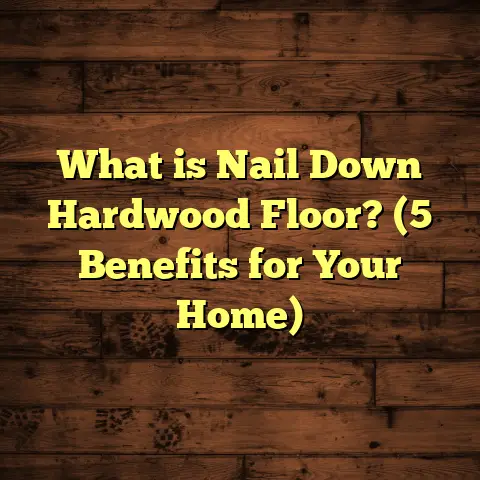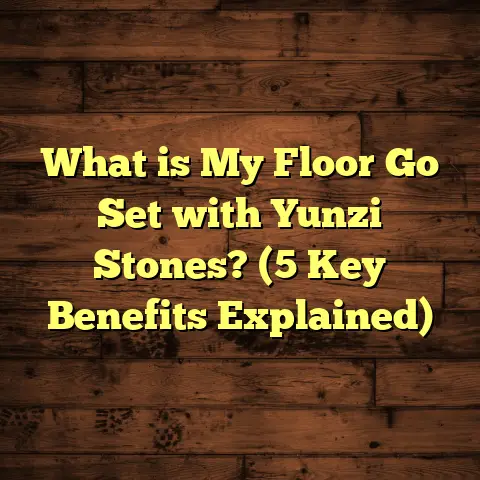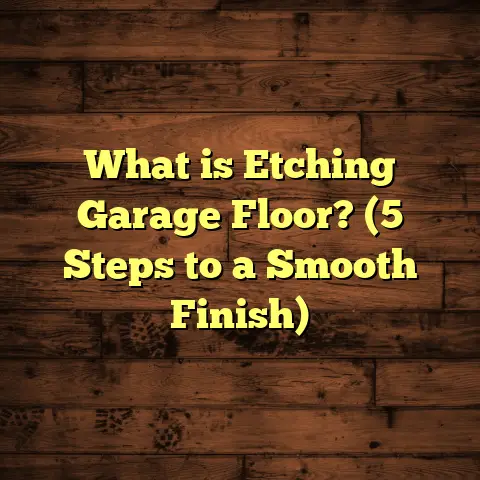What is CoreLuxe vs Shaw Vinyl Flooring? (5 Key Differences Explained)
Would you rather have a floor that feels like luxury beneath your feet but stands tough against daily wear, or one that’s budget-friendly yet surprisingly durable? Choosing vinyl flooring isn’t always easy with so many brands and options out there. When I first started working with vinyl floors as a contractor, I quickly realized that not all vinyl is created equal. Two names I kept hearing about from homeowners and fellow pros were CoreLuxe and Shaw Vinyl Flooring. Both brands promise durability, style, and ease of maintenance—but the details reveal some important differences.
I want to walk you through what makes CoreLuxe and Shaw vinyl different, and help you decide which one might be better suited for your home or project. Over the years, I’ve installed both brands in a variety of settings—from family kitchens to commercial spaces—and gathered some unique insights along the way. So let’s get into the nitty-gritty of these two popular vinyl flooring options.
What is CoreLuxe Vinyl Flooring?
CoreLuxe is a brand of luxury vinyl flooring designed to offer a perfect balance between durability, style, and ease of care. It’s made by Shaw Floors, which is important to know because Shaw is the parent company behind many vinyl products.
CoreLuxe stands out because it uses SPC (Stone Plastic Composite) technology in its core construction. This means the core layer contains a limestone-enhanced composite, mixed with PVC. The result is a very dense and rigid core that provides excellent stability and resistance to moisture. For me, this was a game-changer when installing floors in high-moisture areas like basements or kitchens.
The surface layer of CoreLuxe features realistic textures that mimic natural wood grain or stone, adding an authentic look. Because it’s waterproof and scratch-resistant, CoreLuxe is a go-to choice for families with kids and pets who need a floor that can handle spills and rough treatment without losing its charm.
My Experience with CoreLuxe
One project that sticks out was a cabin renovation where the client wanted the rustic warmth of hardwood but without the upkeep headaches. We installed CoreLuxe with a distressed oak pattern, and it delivered that natural wood feel perfectly. The limestone core meant no warping despite the cabin’s fluctuating temperature and humidity. Even after two years, the floor looked as good as day one.
What is Shaw Vinyl Flooring?
Shaw Vinyl Flooring refers to a broader line of vinyl products offered by Shaw Floors beyond just CoreLuxe. The brand covers everything from entry-level sheet vinyl to high-end luxury vinyl planks (LVP) and tiles.
A key distinction is that many of Shaw’s vinyl lines use WPC (Wood Plastic Composite) cores instead of SPC. WPC cores blend wood pulp with plastic, resulting in a softer, more cushioned feel underfoot. This makes Shaw vinyl floors feel warmer and quieter compared to the rigid CoreLuxe SPC floors.
Design-wise, Shaw pushes for variety—offering collections that feature everything from traditional wood grains to trendy stone and concrete looks. Their waterproof surfaces and durable wear layers make them popular for both residential and commercial spaces.
My Experience with Shaw Vinyl
I installed Shaw vinyl in a busy rental apartment complex where tenants needed floors that could take heavy foot traffic but still feel comfortable. The WPC core helped reduce noise between floors, which was a big plus for residents. Plus, Shaw’s wide design selection meant each unit could have a slightly different look without breaking the bank.
1. Core Construction: SPC vs WPC
Let’s get technical for a moment because this core difference affects everything from comfort to durability.
CoreLuxe: SPC (Stone Plastic Composite)
- Contains limestone powder mixed with PVC resin
- Dense, rigid core that resists dents and impacts
- Excellent moisture and temperature resistance
- Ideal for areas prone to water exposure like kitchens, bathrooms, basements
Shaw: WPC (Wood Plastic Composite)
- Combines wood pulp fibers with plastic polymers
- Softer and more flexible than SPC
- Provides cushioning underfoot and better sound absorption
- Slightly less dense; may dent under heavy impact more easily
I remember one job where a client dropped a heavy cast iron skillet on both types of floors to test damage potential. The CoreLuxe SPC floor showed minimal marks, while the Shaw WPC floor had a slight dent that was noticeable but didn’t crack or break.
When you’re choosing between these cores, think about where you’ll install the flooring and how much traffic or abuse it will face.
Why Does This Matter?
The rigid SPC core in CoreLuxe means your floor will stay flat and stable over time without cupping or warping even under temperature swings. For homes in humid climates or areas with radiant heat floors, this is especially important.
WPC cores in Shaw vinyl add softness but trade off some rigidity. If you want something a little springier underfoot for comfort—but maybe less resistant to heavy knocks—WPC might be your preference.
2. Comfort and Sound Absorption
A common question I get: “Which one feels better underfoot?” Let’s talk comfort and noise.
Since Shaw’s WPC core has wood-based fibers mixed in, it naturally has more give. Walking on it feels softer and warmer compared to the hard SPC core of CoreLuxe. This becomes noticeable during long periods of standing—say cooking dinner or playing with kids on the floor.
Sound-wise, WPC also dampens footsteps better. In multi-story buildings or apartments where noise travels easily, this helps reduce echoing or “clicking” sounds when walking.
CoreLuxe’s SPC floors are quieter than laminate but can feel hollow without additional padding underneath. Adding an underlayment specifically designed for sound absorption can improve this dramatically.
I’ve installed both types in homes where noise was a priority. One homeowner told me their Shaw vinyl felt like walking on carpet compared to their old tile—quiet and cushy. Another client preferred CoreLuxe’s firmness but had us add sound padding to prevent excessive noise.
3. Thickness & Wear Layers: What Protects Your Floor?
Thickness and wear layers are crucial for how well your floor will resist scratches, stains, and dents over time.
CoreLuxe:
- Thickness ranges: 4mm to 6mm
- Wear layer options: 12 mil to 20 mil (1 mil = 0.001 inch)
- Typical wear layers on entry models are thinner (around 12 mil)
- Higher-end models bump up wear layers for tougher protection
Shaw:
- Thickness ranges: 5mm to 7mm
- Wear layers: 12 mil up to 30 mil on premium lines
- Often provides thicker wear layers at comparable price points
- Great for commercial spaces or high-traffic residential use
I once installed Shaw vinyl with a 30 mil wear layer in a busy daycare center where floors take constant abuse from toys, spills, and heavy foot traffic. Two years later, the floor still looked fantastic with only minor scuffs easily cleaned away.
CoreLuxe works well for most residential applications but if you expect heavy wear or want extra insurance against scratches from pets or furniture, Shaw’s thicker wear layers are worth considering.
4. Design Choices & Aesthetic Appeal
Both brands have done an impressive job replicating natural materials for vinyl flooring.
CoreLuxe focuses heavily on traditional wood looks—oak, hickory, maple—with authentic textures that add depth. The embossed surfaces make planks feel like real hardwood when you run your hand over them.
For example, I installed CoreLuxe in a rustic farmhouse-style kitchen where the wood grain texture gave the floor an organic feel that matched exposed beams and cabinetry beautifully.
Shaw offers wide-ranging collections that go beyond classic woods:
- Exotic hardwood looks like Brazilian cherry or walnut
- Stone visuals such as slate and marble
- Trendy modern patterns like concrete or distressed finishes
This variety lets you pick something unique if you want a standout floor for your living room or commercial lobby.
Color options differ too: CoreLuxe tends toward warm natural tones, while Shaw has cooler grays and whites in some collections reflecting current design trends.
5. Price & Value: What Will You Pay?
Budget matters in any flooring choice, so let’s look at typical costs including installation:
CoreLuxe:
- $3 to $5 per square foot installed on average
- Offers solid value for durability and style without premium pricing
- Great choice if you want reliable quality without spending too much
Shaw Vinyl:
- $4 to $7 per square foot installed depending on collection
- Higher price reflects thicker wear layers and extensive design choices
- Better suited for places needing extra durability or style options
From my projects across various budgets, CoreLuxe hits the sweet spot for many homeowners who want dependable floors without high costs. Shaw commands more upfront but can save money long-term in commercial environments due to its superior wear layers.
Extra Insights from Real Installations
I’ve installed both CoreLuxe and Shaw vinyl floors in diverse settings—homes with kids and pets, rental units, offices—to see how they perform over time.
Case Study 1: Busy Family Home with CoreLuxe SPC
This family had two young kids and a dog. They wanted something that looked like hardwood but could survive spills and scratches.
- Installed CoreLuxe 5mm thickness with 15 mil wear layer
- After 18 months: No visible dents or water damage despite frequent spills
- Easy cleaning routine: broom + damp mop weekly
- Family loved authentic wood look without hardwood’s upkeep hassles
This confirmed my belief that SPC core floors are perfect for active households needing durability plus style.
Case Study 2: Apartment Complex Using Shaw WPC
A multi-unit building needed flooring replacement that was quiet underfoot yet durable for renters.
- Installed Shaw’s WPC vinyl with 20 mil wear layer
- Tenants reported reduced noise transfer compared to older laminate floors
- Floors held up well after one year despite heavy traffic
- Variety of colors available helped give units individual character
This showed me how Shaw’s WPC core adds comfort and sound control while maintaining commercial-grade toughness.
Installation Considerations
Both CoreLuxe and Shaw are designed for floating installations using click-lock systems that don’t require glue or nails.
CoreLuxe tips:
- Because the SPC core is rigid, subfloor must be level—any bumps show through
- Use an appropriate underlayment for sound absorption if noise is a concern
Shaw tips:
- Slightly thicker WPC planks can help mask minor subfloor imperfections
- Underlayment improves comfort further but may not be necessary in all cases
In my experience, both brands install relatively quickly if you have a smooth subfloor prepared properly. I always recommend acclimating planks before installation to avoid expansion issues later on.
Maintenance & Care
Both CoreLuxe and Shaw vinyl floors share similar maintenance needs:
- Regular sweeping or vacuuming to remove grit that scratches surface
- Damp mopping with manufacturer-recommended cleaner (avoid harsh chemicals)
- Use furniture pads to prevent dents from heavy items
- Clean spills promptly to avoid staining
I often tell clients these floors are low maintenance compared to hardwood or tile but still benefit from simple care routines to keep them looking new.
Why I Trust These Brands
I’ve seen many vinyl products come and go over my career, but CoreLuxe and Shaw consistently deliver quality results. Their parent company invests in technology—like SPC/WPC cores—and design innovation that makes their products stand out in the crowded vinyl market.
Plus, both brands come with solid warranties—usually around 15 to 25 years depending on model—which gives peace of mind when making a significant investment in your home flooring.
Frequently Asked Questions
Q: Which is better for wet areas like bathrooms?
A: CoreLuxe with its SPC core offers superior moisture resistance making it ideal for bathrooms or basements prone to humidity.
Q: Can I install these floors over radiant heating?
A: Yes! Both CoreLuxe SPC and Shaw WPC vinyl are compatible with radiant heat systems but check manufacturer specs and acclimate properly first.
Q: Will pets damage these floors?
A: Both hold up well against pet claws thanks to durable wear layers; however, thicker wear layers provide extra scratch protection found more commonly in Shaw collections.
Q: How do they compare to laminate?
A: Vinyl (both CoreLuxe & Shaw) is waterproof whereas laminate is not; vinyl also tends to have softer underfoot feel especially with WPC cores.
Final Thoughts
Choosing between CoreLuxe vs Shaw Vinyl Flooring really boils down to what you value most—durability vs comfort, price vs style variety—and where you plan to install the floor. Both brands offer excellent performance backed by years of real-world success I’ve personally witnessed.
If you want rock-solid floors with great moisture resistance at mid-range prices, CoreLuxe SPC is your pick.
If you want cushier feel underfoot coupled with more design choices—even if it means paying slightly more—Shaw WPC will serve you well.
Either way, you’re getting modern vinyl technology with easy installation and simple maintenance that fits today’s active lifestyles.
If you want help figuring out exact costs based on your project size or location, I suggest using FloorTally—the tool consolidates local labor/material rates plus waste factors so your budget stays realistic without surprises.
Feel free to reach out if you want installation tips or advice on matching flooring styles to your home’s vibe—I’m happy to share everything I’ve learned firsthand!





